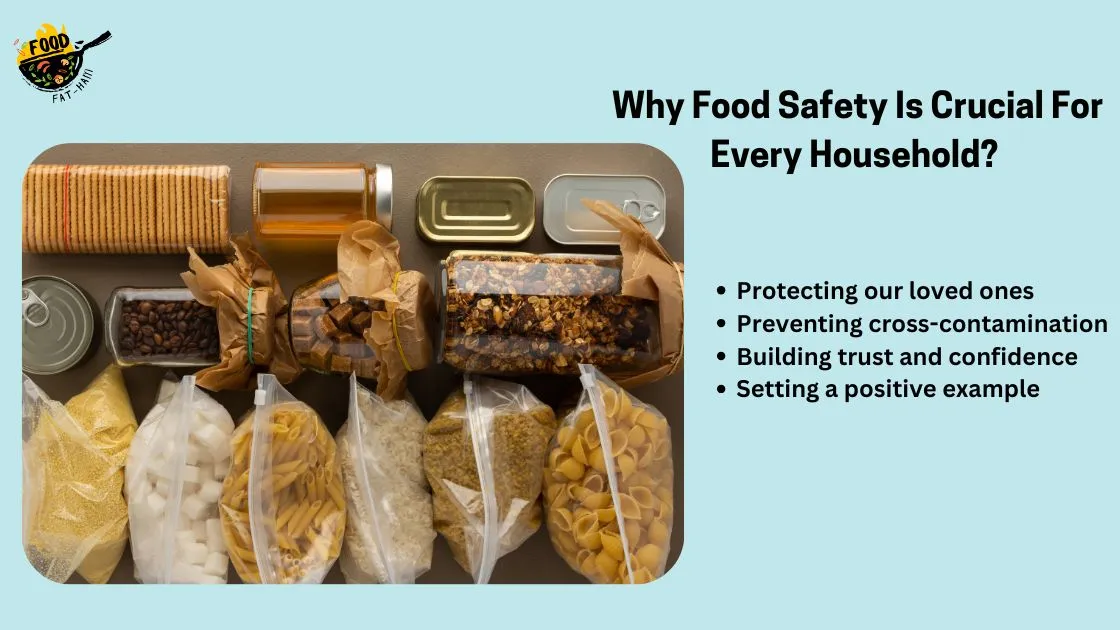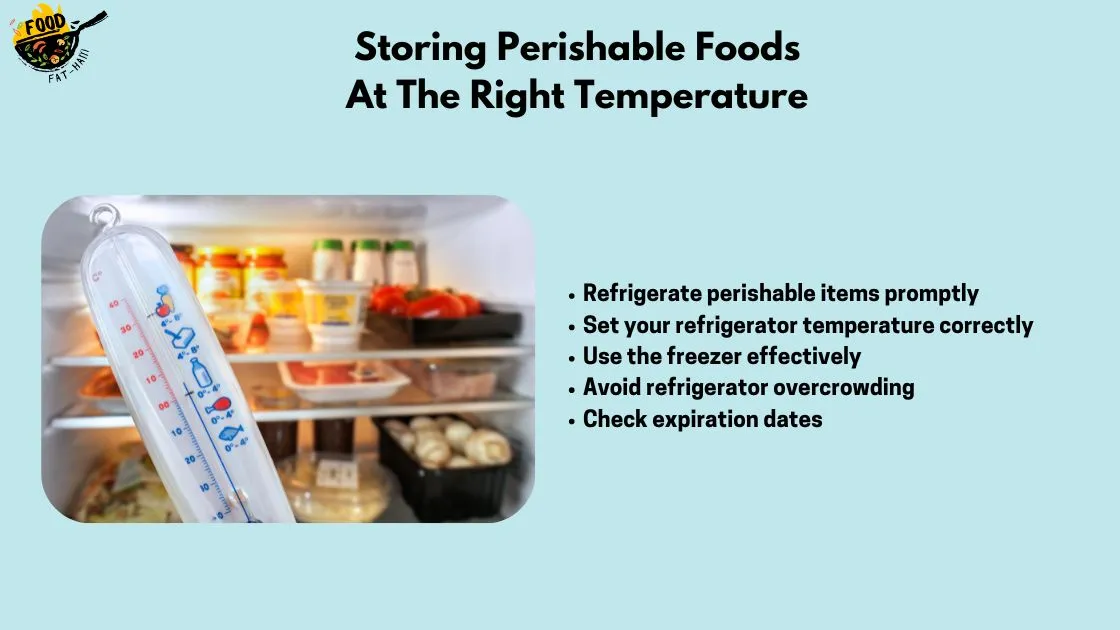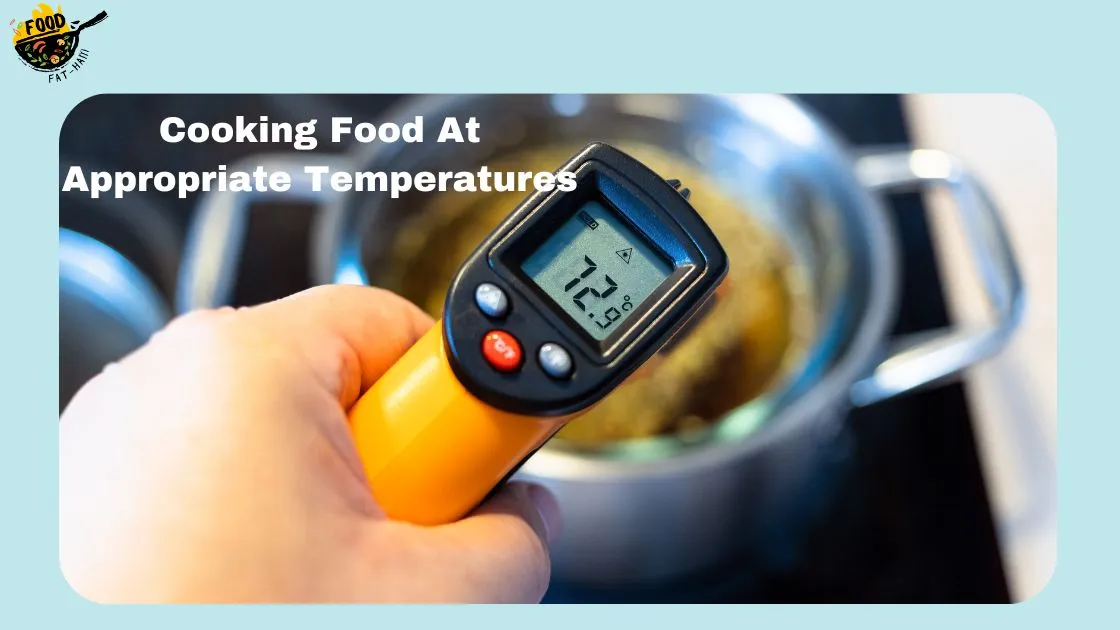Ensuring food safety at home can be achieved through proper handling, storage, cooking, and avoiding cross-contamination. Food safety is of paramount importance to prevent foodborne illnesses and ensure the well-being of our families.
Table of Contents
ToggleIn our own homes, it is vital to handle, store, and cook food properly to eliminate any potential health risks. By following a few simple guidelines, we can avoid the dangers of foodborne illnesses and enjoy safe and healthy meals.
This article will explore various ways to ensure food safety at home, emphasizing the significance of proper handling, storage, cooking techniques, and preventing cross-contamination. By implementing these measures, we can safeguard ourselves and our loved ones from harmful bacteria, viruses, and other contaminants that may be present in our food.
So let us delve into the essential practices for maintaining food safety within the comfort of our own homes.
The Importance Of Food Safety
Maintaining food safety at home is crucial for the well-being of your family. Follow these simple steps to ensure a safe and healthy eating environment.
The Impact Of Unsafe Food On Health And Well-Being
Eating food is not just about satisfying hunger; it is an essential part of our daily lives that directly impacts our health and well-being. However, consuming unsafe food can have severe consequences on our bodies.
Let’s explore the significant impact of unsafe food on our health and the importance of prioritizing food safety at home.
- Foodborne illnesses: Consuming contaminated or spoiled food can lead to foodborne illnesses, such as salmonella, E.coli, or listeria. These illnesses can cause symptoms like stomach cramps, diarrhea, vomiting, and fever. In severe cases, they can even result in hospitalization or, in the worst scenarios, death.
- Weakened immune system: Unsafe food can compromise our immune system, making us more susceptible to infections and diseases. When our bodies are already fighting off harmful bacteria introduced through unsafe food, it becomes challenging for our immune system to defend against other potential threats.
- Long-term health complications: Repeated exposure to unsafe food can have long-term health consequences. It can contribute to the development of chronic conditions such as food allergies, kidney damage, liver disease, or even certain types of cancer. Ensuring food safety becomes crucial in preventing these long-term health complications.
Why Food Safety Is Crucial For Every Household
When it comes to food safety, every household must prioritize it as a fundamental aspect of their daily routines. Understanding the importance of food safety and its direct impact on our well-being is key.

Let’s delve into why food safety is crucial for every household and learn how we can create a safe environment for ourselves and our loved ones.
- Protecting our loved ones: As responsible individuals, it is our responsibility to ensure the safety of the food we prepare and serve to our loved ones. By doing so, we reduce the risk of them falling ill and experiencing any health-related complications due to unsafe food consumption.
- Preventing cross-contamination: Proper handling and storage of food can prevent cross-contamination, which occurs when bacteria from raw food comes into contact with ready-to-eat items. Cross-contamination is a leading cause of foodborne illnesses. Through mindful practices and understanding the importance of separation, we can significantly reduce this risk.
- Building trust and confidence: Prioritizing food safety builds trust and confidence in the meals we prepare for ourselves and others. By implementing safe food practices, we demonstrate our commitment to providing nourishing, healthy, and safe meals, reinforcing our role as caretakers of our household’s health.
- Setting a positive example: When we prioritize food safety in our homes, we set a positive example for others, including children and visitors. By promoting safe food handling and storage practices, we encourage those around us to adopt similar habits, creating a safer culinary culture in our communities.
Remember, food safety is not an optional aspect of our daily lives; it is a crucial component that directly impacts our health and the well-being of those we care for.
By learning the risks of unsafe food and using safe food handling practices, we can keep our homes healthy and safe.
1. Proper Storage And Handling
Proper storage and handling of food is crucial for ensuring food safety at home. This involves maintaining optimal temperatures, organizing perishable items correctly, and practicing good hygiene to prevent cross-contamination.
Storing Perishable Foods At The Right Temperature
Proper storage and handling of foods is crucial to ensuring their safety and preventing any risk of foodborne illnesses. One of the essential steps in this process is storing perishable foods at the right temperature.

Here are some tips to consider:
- Refrigerate perishable items promptly: Store perishable foods, such as meats, poultry, dairy products, and cooked leftovers, in the refrigerator within two hours of purchase or preparation to prevent bacterial growth.
- Set your refrigerator temperature correctly: Keep your refrigerator temperature at or below 40°F (4°C) to slow down the multiplication of bacteria. Use a refrigerator thermometer to ensure accurate temperature control.
- Use the freezer effectively: If you don’t plan to consume perishable items immediately, consider freezing them to maintain their quality and safety. Keep in mind that freezing doesn’t kill bacteria, but it does stop their growth. Label and date items to keep track of how long they have been frozen.
- Avoid refrigerator overcrowding: Proper airflow within the refrigerator is essential for maintaining consistent temperatures. Avoid overcrowding to ensure efficient cooling and prevent temperature fluctuations.
- Check expiration dates: Regularly inspect the expiration dates of perishable items stored in your refrigerator. Discard any foods that have exceeded their recommended shelf life to avoid consumption of spoiled or contaminated products.
Keeping Raw And Cooked Foods Separate
To prevent cross-contamination and reduce the risk of foodborne illnesses, it’s crucial to keep raw and cooked foods separate.
Here are some practices to follow:
- Use separate cutting boards: Designate one cutting board for raw meats, poultry, and seafood, and another one for fresh produce. This prevents the transfer of harmful bacteria from raw foods to ready-to-eat items.
- Store raw meats separately: Keep raw meats, poultry, and seafood in sealed containers or plastic bags to prevent their juices from dripping onto other foods. This reduces the chance of bacterial cross-contamination.
- Use separate utensils: When handling raw and cooked foods, use different utensils, such as knives, tongs, and spatulas, to avoid mixing them. Clean these utensils thoroughly after each use to eliminate any potential bacteria.
- Don’t reuse marinades: If you marinate raw meats, discard the marinade used for the raw product and avoid reusing it for cooked foods. Raw meat marinades can contain harmful bacteria that may not be destroyed during cooking.
- Store leftovers safely: When storing cooked foods as leftovers, place them in separate containers from raw ingredients. Ensure that any juices from cooked meats are not in contact with other foods in the refrigerator.
Using Proper Food Containers And Wrapping Techniques
Choosing the right food containers and employing proper wrapping techniques are essential for maintaining food safety.
Consider the following tips:
- Opt for airtight containers: Use airtight containers to store leftovers and keep them safe from contamination. These containers also help maintain food quality by preserving freshness and preventing odors from spreading.
- Select food-grade containers: When storing foods for an extended period, choose containers specifically designed for food use. These containers are made with safe materials and won’t leach harmful chemicals into your food.
- Wrap foods correctly: When storing foods in the refrigerator or freezer, use proper wrapping techniques to prevent freezer burn and maintain taste and texture. Wrap foods tightly in plastic wrap or aluminum foil, or place them in sealable freezer bags.
- Label and date containers: To avoid confusion and unnecessary waste, label your containers with the name of the food and the date it was stored. This allows you to keep track of how long the food has been in storage.
- Follow recommended storage times: Each type of food has a recommended storage time. Educate yourself about these guidelines and adhere to them for optimal food safety.
By following these tips for proper storage and handling at home, you can ensure the safety and freshness of your food, reducing the risk of foodborne illnesses and promoting a healthy environment for you and your family.
2. Effective Cleaning And Sanitization
Ensure food safety at home with effective cleaning and sanitization methods. Keep your kitchen and food preparation areas clean by regularly washing surfaces and utensils with hot soapy water.
Additionally, sanitize frequently touched objects and follow proper food handling practices to minimize the risk of foodborne illnesses.
Importance Of Washing Hands Before Handling Food
Proper handwashing is a fundamental step in ensuring food safety at home. By washing your hands thoroughly, you can greatly reduce the risks of foodborne illnesses.

Here are a few reasons why washing hands is important:
- Removes harmful bacteria and germs: Washing hands with soap and water for at least 20 seconds eliminates the majority of bacteria and germs that may be present on your hands.
- Prevents cross-contamination: By washing your hands before handling food, you minimize the chances of transferring harmful bacteria from your hands to the food you’re preparing.
- Protects against foodborne illnesses: Many foodborne illnesses are caused by poor hand hygiene. Proper handwashing minimizes the risk of contamination and helps keep you and your family healthy.
Cleaning Kitchen Surfaces And Utensils Properly
Maintaining a clean and hygienic kitchen environment is crucial for food safety.

By following these practices, you can ensure that your kitchen surfaces and utensils are free from contamination:
- Regularly clean kitchen surfaces: Clean countertops, cutting boards, and other food preparation surfaces with hot soapy water after each use. This helps remove any potential bacteria or harmful residues.
- Separate cutting boards for different foods: To avoid cross-contamination, designate specific cutting boards for raw meat, poultry, seafood, and fresh produce. This prevents the transfer of bacteria from one type of food to another.
- Wash utensils thoroughly: After each use, wash utensils such as knives, spatulas, and serving spoons with hot soapy water. Proper cleaning removes any remaining food particles and reduces the risk of bacterial growth.
Utilizing Safe Sanitizers And Disinfectants
In addition to regular cleaning, the use of sanitizers and disinfectants can provide an extra layer of protection against harmful pathogens.
Here are some key points to remember:
- Choose appropriate sanitizers: Use sanitizers that are specifically designed for food contact surfaces. Make sure they are safe to use on the materials in your kitchen, such as stainless steel or plastic.
- Follow manufacturer instructions: Read and follow the instructions provided by the sanitizer manufacturer carefully. Pay attention to the recommended contact time and proper dilution ratios for effective sanitization.
- Consider natural alternatives: If you prefer a more natural approach, vinegar and hydrogen peroxide can also be effective sanitizers. However, it’s important to remember that natural sanitizers may not be as potent as commercial products, so proper usage and contact time are still crucial.
Remember, maintaining cleanliness and practicing proper sanitization are vital steps in ensuring food safety at home. By implementing these measures, you can protect yourself and your loved ones from foodborne illnesses and enjoy meals with peace of mind.
3. Safe Food Preparation Practices
Discover effective ways to ensure food safety at home with safe food preparation practices. By following proper hygiene, handling, and cooking techniques, you can protect yourself and your loved ones from potential foodborne illnesses.
Thawing Frozen Foods Safely
Thawing frozen foods properly is an essential step in ensuring food safety at home.
Here are some guidelines to follow:
The safest method for thawing frozen foods is to transfer them from the freezer to the refrigerator, which allows for slow, even thawing and reduces the risk of bacterial growth. If you need to thaw food more quickly, you can submerge it in cold water, ensuring it’s sealed in a leak-proof plastic bag, and changing the water every 30 minutes to keep it cold.
Avoid using warm or hot water, as it can encourage bacteria to grow. For immediate thawing, the microwave’s defrost function is an option, but it’s essential to cook the food right away to prevent bacterial multiplication.
Cooking Food At Appropriate Temperatures
Cooking food to the right temperature is crucial in killing harmful bacteria and ensuring food safety.

Here’s what you need to know:
- Use a food thermometer: Invest in a good quality food thermometer to accurately measure the internal temperature of cooked foods. This will help you ensure that you’re cooking food to the right temperature.
- Cook poultry and stuffed meat thoroughly: Poultry, such as chicken and turkey, and stuffed meat require thorough cooking to eliminate bacteria like salmonella. Make sure these foods reach an internal temperature of 165°F (74°C).
- Cook ground meats fully: Ground meats, including beef, pork, and lamb, should be cooked to an internal temperature of 160°F (71°C) to kill any harmful bacteria.
- Cook seafood until opaque: When cooking fish and seafood, ensure that they are cooked until they become opaque and flakes easily with a fork. This ensures that harmful parasites and bacteria are destroyed.
Avoiding Cross-Contamination During Food Preparation
Cross-contamination can occur when bacteria from one food item spreads to another, increasing the risk of foodborne illnesses.
Follow these practices to prevent cross-contamination:
Store raw meats, poultry, seafood, and eggs away from ready-to-eat foods in the refrigerator to prevent any drips or leaks from contaminating other food items.
Have designated cutting boards and utensils for raw meats and another set for fruits, vegetables, and ready-to-eat foods. This reduces the chances of cross-contamination.
Wash your hands with soap and water before and after handling raw foods. Clean cutting boards, countertops, and utensils with hot, soapy water to eliminate any bacteria.
By following these safe food preparation practices, you can greatly reduce the risk of foodborne illnesses and ensure the safety of your meals at home.
4. Understanding Food Labels And Expiration Dates
Understanding food labels and expiration dates is essential for ensuring food safety at home. By carefully deciphering the information provided on labels, consumers can make informed choices and avoid consuming expired or potentially harmful products.
Reading And Interpreting Food Labels Accurately:
Understanding food labels is crucial for ensuring food safety at home. By being able to read and interpret food labels accurately, you can make informed decisions about the quality and safety of the products you consume.
Here are some tips to help you navigate through food labels effectively:
- Look for the ingredient list: The ingredient list is where you can find all the components that make up the product. Be vigilant for any allergens or additives that you or your family members may need to avoid. It’s also essential to understand that ingredients are listed in descending order by weight, with the most abundant ingredient listed first.
- Pay attention to serving sizes: Serving sizes can often be misleading, as they may not reflect the amount you typically consume. Understanding the serving size can help you evaluate the nutritional content accurately.
- Check for nutritional information: The nutrition facts panel provides vital information about the product’s nutritional content. Be aware of the calories, macronutrients (such as carbohydrates, fats, and proteins), and micronutrients (such as vitamins and minerals). This information can help you make healthier choices and meet your dietary needs.
- Be aware of claims and certifications: Labels often include claims such as “organic,” “non-GMO,” or “gluten-free.” Familiarize yourself with the definitions of these claims to make sure the product aligns with your preferences or requirements.
- Understand date labeling: Date labeling refers to the “best before” and “use by” dates, which indicate the freshness and quality of the product. Familiarize yourself with these terms to ensure that you consume the product before it expires.
Recognizing Different Types Of Expiration Dates:
Expiration dates on food products can vary, and recognizing the different types is crucial for maintaining food safety.
Here’s a breakdown of the various expiration dates you may encounter:
- “Best before” date: This date indicates the quality of the product. It suggests that the item is at its best quality until the specified date but is generally safe to consume afterward. However, the taste, texture, and nutritional value may deteriorate over time.
- “Use by” date: The “use by” date is an indicator of when the product is at its peak freshness and safety. It signifies the last day the manufacturer recommends consuming the item for optimal quality and safety.
- “Sell by” date: The “sell by” date is primarily for retailers, indicating the last day the store should display the product for sale. Consumers can still purchase and consume these products beyond this date if stored properly and if the product exhibits no signs of spoilage.
It’s crucial to pay attention to these expiration dates and make informed decisions based on the type of date provided.
Properly Storing And Disposing Of Expired Food Items:
Proper storage and disposal of expired food items are essential to maintain food safety and prevent any potential health risks. Here are some guidelines to follow:
- Store perishable foods correctly: Perishable items like dairy products, meat, and seafood must be refrigerated at or below 40°F (4°C). Keep raw meats separate from other foods to prevent cross-contamination. Freezing can extend the shelf life of many perishable items, but make sure to label and date them properly for identification.
- Use the “first in, first out” rule: When storing food items, follow the “first in, first out” principle. Consume the oldest products first to ensure that nothing goes past its expiration date.
- Check for signs of spoilage: Before consuming any food, inspect it for signs of spoilage such as strange odors, discoloration, mold, or an off texture. If any of these are present, it’s best to discard the item to avoid the risk of foodborne illnesses.
- Dispose of expired food properly: When discarding expired food, make sure to seal it in a bag or container to prevent contamination. If possible, compost any food waste to reduce its impact on the environment.
By understanding food labels, recognizing expiration dates, and adopting proper storage and disposal practices, you can ensure food safety at home and protect the well-being of yourself and your loved ones. Stay informed and make conscious choices when it comes to the food you consume.
5. Identifying And Preventing Foodborne Illnesses
Learn how to keep your food safe at home and prevent foodborne illnesses with these essential tips. From proper storage to thorough cooking, you’ll discover effective ways to identify and avoid potential health risks in your kitchen.
Foodborne illnesses can result from consuming contaminated food or beverages, leading to uncomfortable symptoms and potential health risks. By taking the necessary precautions and practicing safe food handling, you can significantly reduce the risk of foodborne illnesses. Here are some key points to consider:
Common Foodborne Illnesses And Their Symptoms
- Salmonella: Symptoms include diarrhea, abdominal pain, fever, and vomiting.
- E. Coli: Symptoms include severe stomach cramps, bloody diarrhea, and vomiting.
- Norovirus: Symptoms include nausea, vomiting, diarrhea, stomach cramping, and sometimes fever.
- Campylobacter: Symptoms include diarrhea, abdominal pain, fever, and nausea.
- Listeria: Symptoms may include fever, muscle aches, headache, stiff neck, confusion, loss of balance, and convulsions, sometimes preceded by diarrhea or other gastrointestinal symptoms.
Practicing Safe Food Handling To Reduce The Risk Of Contamination
Wash hands thoroughly with soap and warm water for at least 20 seconds before and after handling food. Keep raw meats and their juices separate from ready-to-eat foods to avoid cross-contamination. Use separate cutting boards for raw meats and other foods to prevent the spread of bacteria. Cook food to the right temperature to kill harmful bacteria.
Use a food thermometer to ensure proper cooking. Refrigerate perishable foods promptly to prevent bacterial growth. Keep your refrigerator at or below 40°F (4°C). Regularly clean and sanitize kitchen surfaces, utensils, and equipment to prevent the buildup of harmful bacteria.
Taking Necessary Precautions During Food Preparation
Thoroughly rinse fresh fruits and vegetables under running water before consuming or cooking them. Avoid consuming raw or undercooked eggs, meat, poultry, and seafood. Store leftovers in small, shallow containers to help them cool quickly and prevent bacterial growth.
When reheating leftovers, ensure they reach an internal temperature of 165°F (74°C) to kill any potential bacteria. Pay attention to expiration dates and properly discard any expired or spoiled food. Maintain good personal hygiene and avoid preparing food if you are sick, especially if you have symptoms such as diarrhea or vomiting.
By understanding common foodborne illnesses, practicing safe food handling, and taking necessary precautions during food preparation, you can safeguard yourself and your family from the risks of foodborne illnesses. Remember, prevention is key when it comes to ensuring food safety at home.
6. Proactive Pest Control Measures
Protect your home from pests with proactive measures such as regular cleaning, sealing cracks and crevices, using organic pest control methods, storing food properly, and maintaining a clean kitchen. These steps ensure food safety and prevent the spread of diseases.

Preventing Access And Infestations Of Pests In The Kitchen
Maintaining a pest-free kitchen is crucial for ensuring food safety at home. By adopting proactive measures to prevent access and infestations of pests, you can create a clean and hygienic environment.
Here are some effective steps you can take:
- Seal all openings and cracks: Inspect your kitchen for any openings or cracks that pests can crawl through. Use caulk or sealant to seal these gaps and openings to block their entry points.
- Keep food containers tightly sealed: Store all food items, including pantry staples, in tightly sealed containers to deter pests from accessing them. This will help prevent contamination and keep pests at bay.
- Clean up spills and crumbs promptly: Pests are attracted to food spills and crumbs left on countertops, floors, and inside cabinets. Regularly clean up any spills to eliminate potential food sources and discourage pests from lingering.
- Dispose of garbage properly: Securely cover your garbage bin with a tight-fitting lid and take out the trash regularly. This will prevent pests from scrounging for food and breeding in the trash.
- Store fruits and vegetables properly: Storing fruits and vegetables in the refrigerator or in fruit bowls with covers will deter pests from infesting them. Additionally, regularly inspect and discard any rotten produce to avoid attracting pests.
By implementing these preventive measures, you minimize the chances of pests infiltrating your kitchen and compromising food safety.
Recognizing Signs Of Pest Presence And Taking Immediate Action
Vigilance in recognizing signs of pest presence is vital to prevent infestations and maintain a safe kitchen environment. Be aware of the following indicators and take immediate action when necessary:
- Droppings and urine: Pest droppings and urine are clear signs of infestation. If you notice any small, pellet-like droppings, smudges, or staining, it’s time to take action.
- Gnaw marks: Pests, such as rodents, leave gnaw marks on food packaging or wooden structures. Inspect your kitchen for any signs of gnawing, which can suggest a current or potential infestation.
- Foul odor: A persistent foul odor, especially in hidden or hard-to-reach areas, may indicate the presence of pests. Investigate the source and address it promptly.
- Nesting materials: Discovering nests or nesting materials in your kitchen is a sign that pests have made themselves at home. Remove and eradicate these materials immediately.
- Visible pests: If you spot pests like cockroaches, ants, or rodents in your kitchen, it’s essential to take immediate action to prevent further infestation.
When faced with any of these signs, it’s crucial to promptly address the situation by seeking professional pest control assistance or using appropriate pest control products.
Safely Using Pest Control Products To Maintain A Safe Environment
Using pest control products necessitates proper precautions to ensure the safety of your family, pets, and the environment.
Here are some guidelines to follow:
Before using any pest control product, carefully read and understand the instructions, including safety precautions and recommended usage guidelines. Always wear appropriate protective gear, such as gloves, goggles, and masks, to minimize exposure to chemicals. Keep children and pets away from treated areas until it is safe for them to return.
Store pest control products securely in their original containers, tightly sealed, and out of reach of children and pets, following any specific storage instructions on the packaging. Dispose of empty containers responsibly, in accordance with local regulations, and avoid pouring or rinsing chemicals down drains or toilets to prevent environmental contamination.
By adhering to these precautions, you can effectively and safely use pest control products to maintain a safe environment within your home. Remember, if the infestation persists or worsens, it is advisable to seek professional pest control services for comprehensive eradication.
Frequently Asked Questions On Ways Of Ensuring Food Safety At Home
What Are The 4 Key Ways To Ensure Food Safety?
Ensure food safety by following these four key guidelines: 1. Keep your hands clean, thoroughly wash them before handling and preparing food. 2. Store food properly, making sure to keep raw meats separate from other items in the refrigerator. 3. Cook food at appropriate temperatures to kill any harmful bacteria, using a food thermometer to ensure accuracy.
4. Practice good food handling techniques, avoiding cross-contamination and properly reheating leftovers.
What Are The 5 Basics Of Food Safety?
The 5 basics of food safety include proper handwashing, separation of raw and cooked food, cooking food thoroughly, storing food at safe temperatures, and avoiding cross-contamination.
What Are 7 Tips To Keep Food Safe?
Here are 7 tips to keep food safe: 1. Wash your hands before handling food and after touching raw meat. 2. Separate raw and cooked foods to prevent cross-contamination. 3. Cook food thoroughly to kill harmful bacteria. 4. Store leftovers properly in the refrigerator to prevent bacteria growth.
5. Use safe water and clean utensils when preparing food. 6. Avoid consuming expired or spoiled food to prevent foodborne illnesses. 7. Be mindful of food allergies and keep allergens separate from other foods. By following these guidelines, you can ensure the safety of your food.
How Can I Ensure Food Safety At Home?
To ensure food safety at home, always wash your hands before handling food, cook food thoroughly, and store leftovers properly in the refrigerator. Additionally, avoid cross-contamination by keeping raw and cooked foods separate, and regularly cleaning your cooking utensils and surfaces.
Conclusion
Ensuring food safety at home is of utmost importance for the well-being of ourselves and our loved ones. By following these simple guidelines, we can minimize the risk of foodborne illnesses and create a safe environment in our kitchen. First and foremost, practicing good hygiene such as washing hands thoroughly is imperative.
Secondly, storing food at the correct temperature and avoiding cross-contamination is crucial. Regularly cleaning and sanitizing kitchen surfaces and utensils also plays a significant role in preventing foodborne diseases. Furthermore, staying informed about safe food handling practices and keeping up with the latest guidelines can greatly contribute to maintaining a safe and healthy home.
Remember, food safety is a continuous process, and everyone has a role to play in ensuring that we enjoy our meals without any risks. So, let’s prioritize food safety and make it a part of our everyday life. Together, we can create a safe and healthy environment in our homes.



